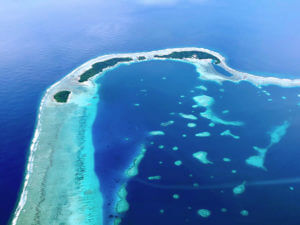
After World War II, many countries were competing to win the nuclear race. The United States and the Soviet Union were two of the main countries in this rivalry. They wanted to have better weapons than the other, so they started making nuclear bombs.
Many people know about major events like the Cuban Missile Crisis and the Chernobyl disaster, but not many know about all the nuclear testing that happened in a place called Bikini Atoll in an island country called the Marshall Islands. This testing damaged the environment and people who lived there for a long time.
In this blog, we’ll explore the history of Bikini Atoll testing and how it affected the island and its people.
What is Bikini Atoll?
Bikini Atoll is one of the many islands that make up the Marshall Islands, located in the Pacific Ocean. It’s a small ring-shaped island with stunning beaches and vibrant marine life. However, Bikini Atoll is also known for something much darker—nuclear testing.
Why Was Nuclear Testing Done at Bikini Atoll?
After World War II, the United States wanted to test nuclear bombs to understand their power and impact. Bikini Atoll was chosen because it was far from any major cities, and the U.S. believed it would be a safe place to conduct these dangerous tests.
The History of Nuclear Testing at Bikini Atoll
In 1946, the U.S. government relocated the residents of Bikini Atoll to other islands, promising them that they could return once the tests were completed. The first Bikini Atoll nuclear test was called “Operation Crossroads.” It involved two main tests:
- Able Test: On July 1, 1946, a bomb was dropped from an airplane and exploded above the water.
- Baker Test: On July 25, 1946, another bomb was detonated underwater, creating a massive explosion and sending radioactive water into the air.
After Operation Crossroads, more tests continued in the 1950s. One of the most famous tests was the Castle Bravo test in 1954. This was the largest nuclear explosion ever conducted by the U.S., and its effects were even more devastating than expected.
Castle Bravo
The Castle Bravo test created a crater and spread radioactive fallout over a large area. The fallout reached other islands in the Marshall Islands, affecting many more people. Those exposed to the fallout suffered from radiation sickness, burns, and long-term health problems like cancer.
Trying to Return Home
In the 1960s, some Bikini Atoll residents tried to move back to their island. However, they found out that the land and food were still contaminated with radiation. This made it unsafe to live there. The U.S. government had to relocate them again.
The Effects of Bikini Atoll Testing
Environmental Impact
When the Bikini Atoll was used for nuclear testing, it caused a lot of damage. The explosions destroyed ships and coral reefs and made big holes in the ocean floor. But that wasn’t all. The tests also released dangerous radiation that made the water, land, and air unsafe.
Long-Term Consequences
The Bikini Atoll testing in the Marshall Islands caused a lot of harm to both the environment and people. The people who lived there couldn’t go back home, because it was still very dangerous. Some major issues were:
- Health Issues: Many people exposed to radiation developed serious health problems, including cancer and birth defects. These individuals are known as Bikini Atoll radiation victims.
- Environmental Damage: The radioactive fallout affected marine life and ecosystems. This makes the island unsafe to fish and grow food.
- Displacement: The people had to leave their homes and live somewhere else, often in bad conditions, without knowing if they could go back.
Efforts to Address the Impact
Over the years, there have been efforts to clean up the radiation and make Bikini Atoll safe again. However, it is a challenging and ongoing process. The U.S. government has provided some compensation to the Marshall Islands radiation victims, but many believe that more needs to be done.
File Your Claim to Get Your Compensation
If you or a loved one has been affected by health issues due to Bikini Atoll testing, you may be entitled to significant compensation under the Radiation Exposure Compensation Act (RECA).
At the Cancer Benefits Center for Downwinders, we can help determine if you or your loved one qualify based on the location, time of exposure, and diagnosed health conditions. If you are eligible for compensation, we will help you gather all necessary documentation to maximize your chances of receiving full compensation.
If you would like to learn more about Bikini Atoll testing or want to get started with us, contact us using our easy-to-fill registration form. We look forward to serving you.
